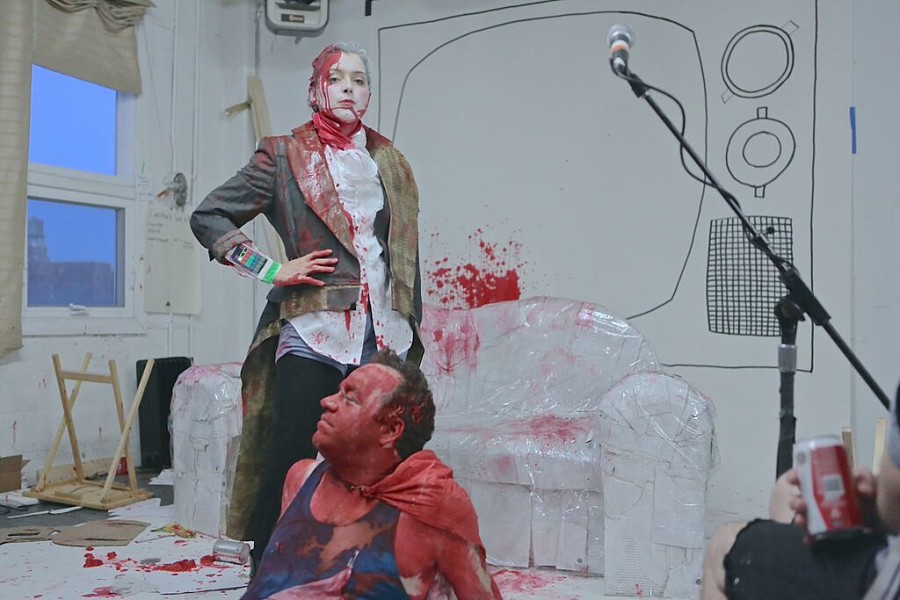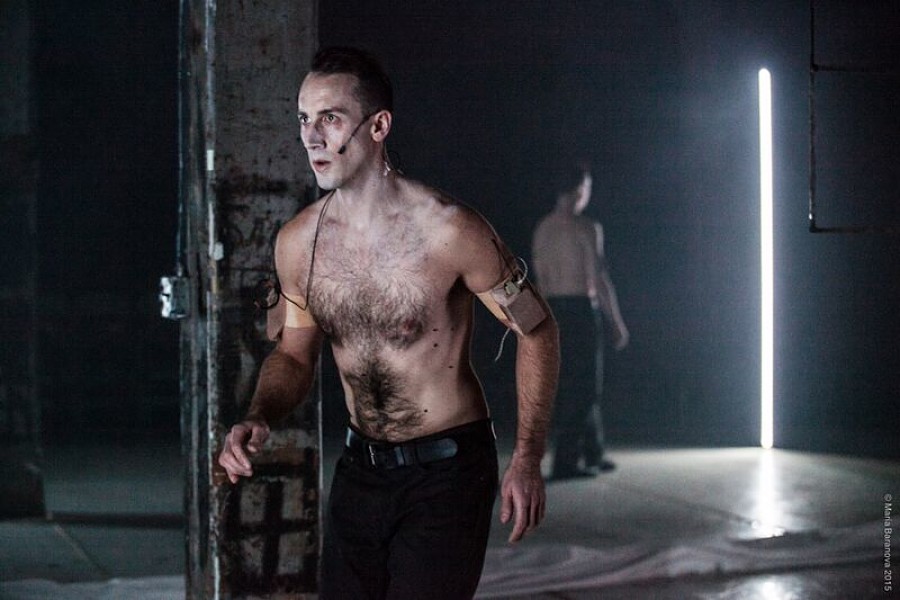BARRINGTON, MASS.: Can theatre affect its audience on a neurological level? Can it bend your mind into synesthesia—experiencing one sense as another? That’s nothing less than performance artist Andrew Schneider’s goal with YOUARENOWHERE, the piece he first presented in January at the COIL festival and is now touring as far as France and Australia; the show will next appear at Mass Live Arts, a performance festival that runs in the Berkshires July 6–26.
With references to quantum physics, missed connections, love, and time, YOUARENOWHERE takes place in the theatre space in front of you, but it transcends mere space; there’s an aspect of the show that’s happening inside your own mind. Like a theatrical virus, Schneider’s remarkable, nearly indescribable show breaches the blood-brain barrier, and with great intimacy and intensity strikes you in a vulnerable place. If you feel both moved and a bit brain-scrambled after seeing it, Schneider has been successful.
As I spoke recently with Schneider about his work and career, it was clear that while he wrestles with complex ideas and concepts, emotion is at the core of his work. “I’m really interested in curating emotion without narrative, because I don’t have stories that I want to tell,” he said. “But I’m really interested in people and moments, and how you get to a particular moment.”
In its third year, Mass Live Arts is establishing itself as the go-to place for contemporary performance among the Berkshire summer theatre festivals. Artistic director Ilan Bachrach, who presents an array of artists at various stages of their careers, describes his task as “hav[ing] three weeks to blow people’s minds as many times as possible.”
This year Bachrach hopes to accomplish that through live performances, films of Wooster Group performances, gallery installations by artists such as The National Theater of the United States of America and Daniel Fish, even an educational program for college students run by Phil Soltanoff. In addition to Schneider, who performs YOUARENOWHERE in the fest’s opening week, July 9–11, performances this summer include Joseph Silovsky’s Send for the Million Men, a puppet, robot, and object show about the failures of the judicial system and the Sacco and Vanzetti case (July 16–18); Radiohole’s Tarzana, a world premiere comic-book/punk rock bacchanalia (July 23–25); and work-in-progress shows from resident artists Faye Driscoll (July 14)and Heather Fisch (July 23). Performances are held at the Daniel Arts Center.
“Everyone this year—it’s either the first time that show has toured outside of New York City or the first time that show has happened,” says Bachrach.
But it’s not all about the newest of the new; the festival also points to the history of contemporary performance with videos of the éminences grises of the field, the Wooster Group. Bachrach noted an interesting convergence: that every artist this year has a Wooster connection.
“Andrew [Schneider] was an intern on House/Lights and then he was their video designer forever,” said Bachrach. “On Joe [Silovsky’s] show, Victor [Morales] was part of the Wooster Group and Eric [Dyer] performs with them. And then Radiohole is involved with Wooster Group in myriad ways.”

Schneider pays the Wooster Group tribute; they “chang[ed his] idea of what you can make and what people can consume.” Of his time with the legendary company and director Elizabeth LeCompte, he said, “I think all of my senses got tuned in a really good way by being in that room,” he notes.
A fine-tuned sensibility informs all aspects of Schneider’s work: He is behind every light, sound, movement, and word. YOUARENOWHERE creates a remarkable experiential environment. With rapid-fire dialogue, bending soundscapes, and flickering lights, all aspects of the performance connect to this sensory-overload aesthetic. In the show, Schneider speaks at such a pace that you can hardly keep up, but, as he noted, “It’s not about the words. It’s about the overall effect, as a texture, as a color.” This theatrical sensation is intended to replicate our neurological experiences, he said. “That’s how our brains work. It’s just shifting between things so rapidly. And I wanted to see that in a physical space.”
Schneider, a graduate of NYU’s Interactive Telecommunications Program, has for many years built his own technology to use in his work. True to form, the technology employed in YOUARENOWHERE did not exist before Schneider created it; he needed the sound and lights to do things beyond what they were designed to do. But he’s not using technology for cool effects or merely a stylistic touch. Explained Bachrach: “[Schneider] made new technology to make you feel a new thing. The technology did not exist to get the feeling he wanted and he knew that. He knew no lighting that existed could do that, so he made one that did. In doing so, he created the possibility to feel or experience this whole new thing.”
The result is something that Schneider thinks has “landed in this really great way” and “is really delicate.” It’s so delicate, in fact, that I’m reticent to say much more about the content of the show. Suffice to say that Schneider’s theatre alchemy results in something beautiful, affecting, magical, and surprising.
Schneider’s next project promises to be equally challenging: He said he’s developing a work at New York City’s Dixon Place, with Abrons Arts Center, currently titled Unified Field Theory. Its influences include the works of light-and-space artists Robert Irwin and James Turrell.
“Their process and the way that they talk about their work is becoming integral to how I’m thinking about my own work,” said Schneider. When asked what Unified Field Theory is going to involve, he says, “This show is going to be a lot of darkness, a lot of fucking with perception.” He’s even enlisted the help of a neuroscientist to help him achieve that.
In talking with Schneider about artists taking risks and audiences blindly trusting them, I shared the experience I had with British artist Verity Standen’s show HUG. In that piece, I was blindfolded, not knowing what to expect. A group of vocalists entered singing, and then one took me in their arms and hugged me. It was incredible—though everyone I described it to was horrified either by the idea of the blindfold or the hugging or both.
Schneider, though, seemed excited to hear about it.
“My inability to actually connect with people on really deep level—that’s why I’m making the work that I make,” he told me. “I can see myself making that show. That’s exactly what I am trying to do with my work: hug you.” He started to laugh, then paused for reflection. “Hmmm. Like it’s a deep need, to kind of just say, right, we’re all here.”


